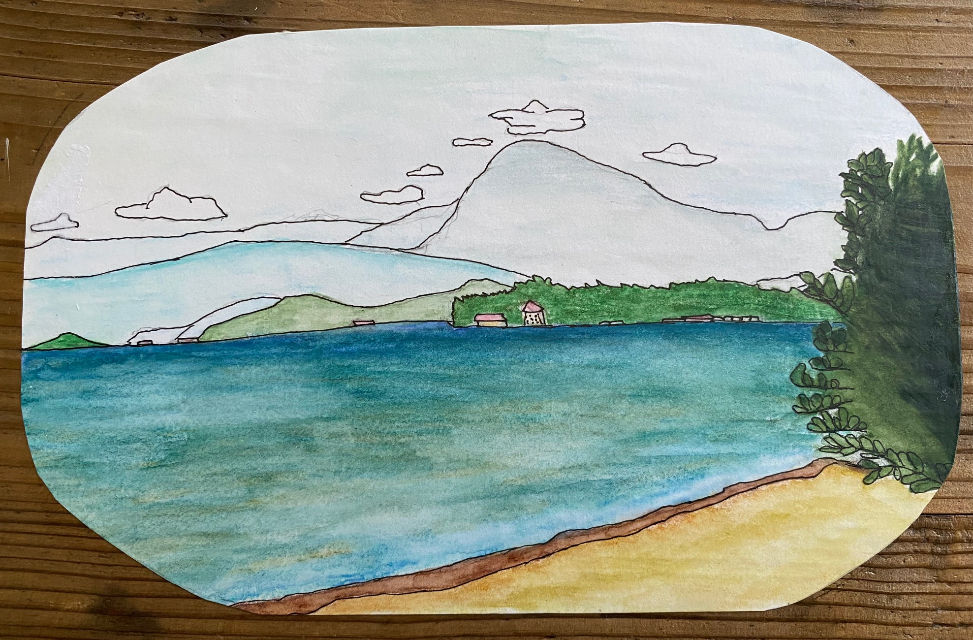STRUGGLING ARTIST SHOOTS SELF IN FOOT, SAYS “IT DOESN’T HURT”
- Rebecca Otowa
- Oct 21, 2020
- 5 min read

My husband recently bought a handmade wok at a craft fair. It cost 8000 yen -- the equivalent of about $90 US. I didn’t object, because I have often done the same thing: bought something handmade by an artist or artisan for a rather high price, knowing how long it took to make and how much dedication was required to learn how to do this difficult thing by hand in the first place. Plus, the objects are usually well made and last a long time.
The same day, my grandchildren, who were probably influenced by what they saw at the craft fair, got out their little pompoms and hot glue gun and made some Christmas decorations out of pinecones, chestnuts, etc. Then they set up a shop and offered these things to the family for sale (for “real money”). I was happy to encourage them in both their artistic pursuit and their entrepreneurship. I remember doing exactly the same thing as a child – drawing or painting pictures and offering them for sale to my family. I think I was a lot like my dad in this, who was always creating – having ideas, drawing them up, and sending them to the patent office. He did have a couple of patents, too. He was always creating, and also thinking about how his creations could make money. Unfortunately, they didn’t, much.
My ideas about this changed a little as I grew up, though. When I became a published author, I discovered with consternation that promoting the book was partly my job (though being published by a well-known firm eased this burden quite a bit). I had all the labor of writing the book; wasn’t it someone else’s job to promote it? The two activities – creation and salesmanship – are very different and require different, sometimes contradictory, skills.
The former, at its most pure, is undertaken just for the joy of creating. It doesn’t even enter my head to say “Hey, I could sell this!” The latter evaluates the item or activity with a view to turning it into money. To sales people, it is a waste to create just for the sake of creating. You have to “put it out there”.
Ironically, for the artist, the thought “Hey, I could sell this!” is often the very thing that kills creativity. I often wonder why budding authors are encouraged to visualize their future readers, to imagine who they are writing for. To me, this is the easiest way to kill the creative urge. I write for myself, because I can no more suppress this urge to write than I can stop breathing. It is the same with other things I create. I do it because I can’t not do it.
The other day I went to a wonderful museum in Kyoto that displays the creations of some contemporary netsuke makers. A netsuke was a highly decorative part of a samurai or scholar’s outfit when everyone wore kimono. It was a small toggle at the top of a cord; on the other end of the cord was a small purse or container for tobacco or medicine. The toggle would keep the item from working itself loose from its position at the waistband and getting lost. This functional little object, like so many other things in Japanese art, became an objet d’art in itself and these carved figures are still made by hand by dedicated craftsmen.
I was entranced by the beauty and delicacy of the netsuke. The curator of the museum was much exercised as to how to “put them out there” – to devise a way that these toggles could be part of a modern wardrobe. Unfortunately, the time required to create them means that they are very expensive (as a ballpark figure, I would say $1000 or more). If they hung from a purse by Prada or Dolce & Gabbana, maybe they could be sold. But ordinary people would be fine with a $10 replica made of plastic that could hang from their backpack or whatever. So these artists are struggling.
My husband and I discussed this at length on our way home from the museum: the question of how these artists could make a living at their craft. But now I wonder. If they sold their designs to a mass-producer who would make cheap replicas, for example, wouldn’t they just get ripped off? The original creator of these things is almost never credited. And if they attempted to sell their objects one by one to a professional designer etc., they would quickly enter the quagmire of insuring their intellectual property and many other legal headaches. And they would probably get ripped off anyway.
Wouldn’t they be happier as they are, just having a different job to bring home the bacon (I’m guessing) and creating their wonderful things on the side, whether or not they would ever be “seen out there”? I’m generalizing here. Most likely some of these craftsmen would be delighted to enter the high-pressure world of serious promotion.
The present-day world is not kind to artists. Those who create, unless they are also prepared to promote, can’t live by their craft. This is why I try to help people like this where I can, at local craft fairs and exhibitions. I don’t really need the things I buy, but from the artist’s point of view, the joy of having someone look at your creation and decide “I want this” is very great. And I also have the joy of owning a one-of-a-kind object that was made with love and care by someone I personally know. That’s unusual in ordinary life today.
In the old days as well, artists and artisans lived a rather hard life, unless they could get work under a patron. But their work was still made by hand, and even if their names have faded into antiquity, we can still enjoy the inventiveness of the gargoyles on a 12th century cathedral or a beautifully carved wooden stair banister in an old pub somewhere.
Having a patron is also, mostly, a thing of the past. Some billionaires do patronize artists of various types, or use their money to make sure museums and other artistic venues still survive. But generally speaking, artists deserve the adjective “struggling”. To quote George Orwell, “The poet starving in a garret – but starving, somehow, not uncomfortably” (Keep the Aspidistra Flying) is something that they don’t mind as long as they can continue to create. I myself am, happily, not uncomfortable. That’s because I do have a patron – it’s my husband. Because of his encouragement, I can spend a large part of my days simply creating. My paintings are all over the walls of our house, and occasionally, they do get “put out there”, but I have actually sold only two of the originals. (I have sold replicas in various forms.) And happily, I don’t have to do a lot of self-promotion in order to eat. Many people would say I am crazy, that I ought to offer my things for sale in various ways, but it’s not the way I want to spend my time. I’d rather just create more, because it’s the process I love.
Perhaps artists do sometimes “shoot themselves in the foot” in the sense that they aren’t very skillful at self-promotion. But maybe they are happy anyway, in the process of creation.



Hi Rebecca,
That was a great article and you" hit the nail on the head".
I am a designer and fabricator that works in all kinds of materials.
I do woodturning, blacksmithing, all kinds of metalwork ( jewelry-gold and silver ) iron, etc., furniture and cabinets, sculpture in different materials, etc.
Also, I support other artists by buying their work. People come to my house and say this is a museum. I have a friend that is a ceramic artist and sells in Japan. I have a lot of work by Jeff who makes Japanese-style pottery. Because of the virus, he has suffered because he can not do shows and it is hard to have people come to his studi…